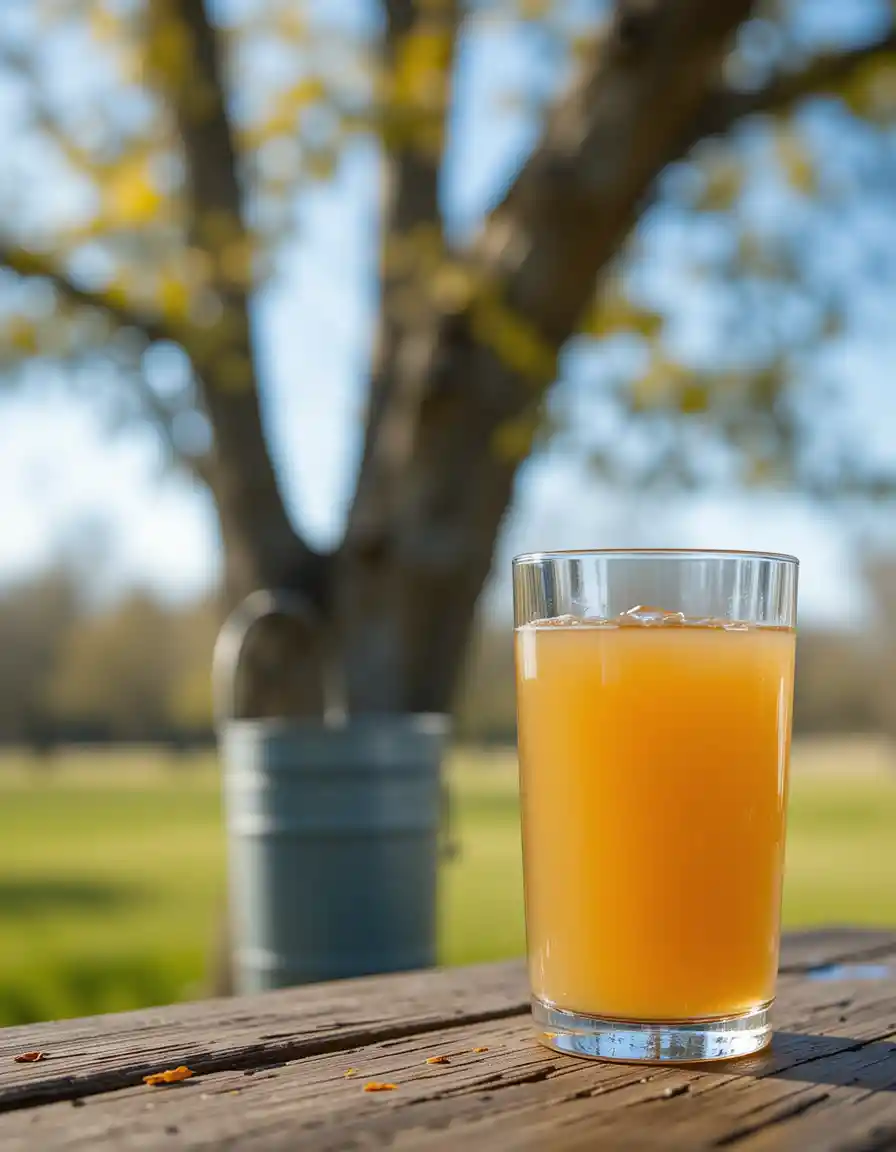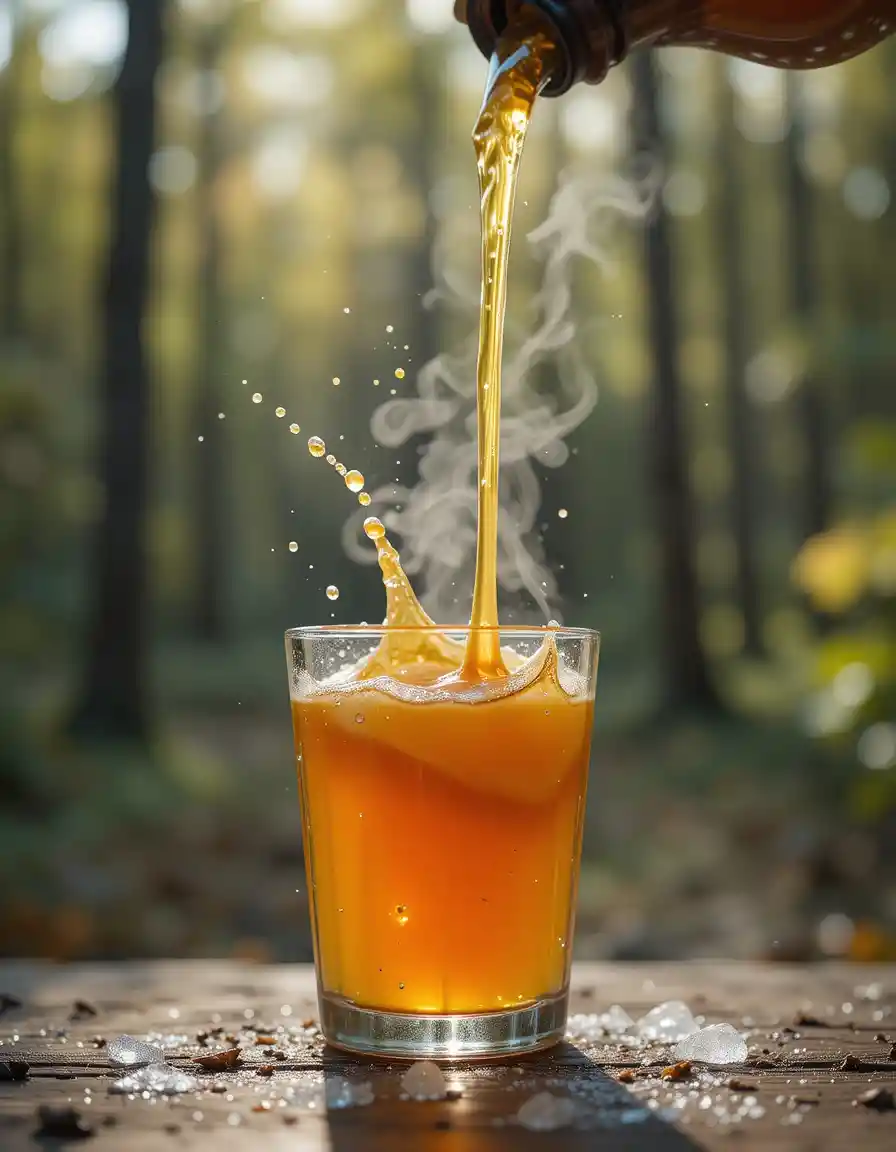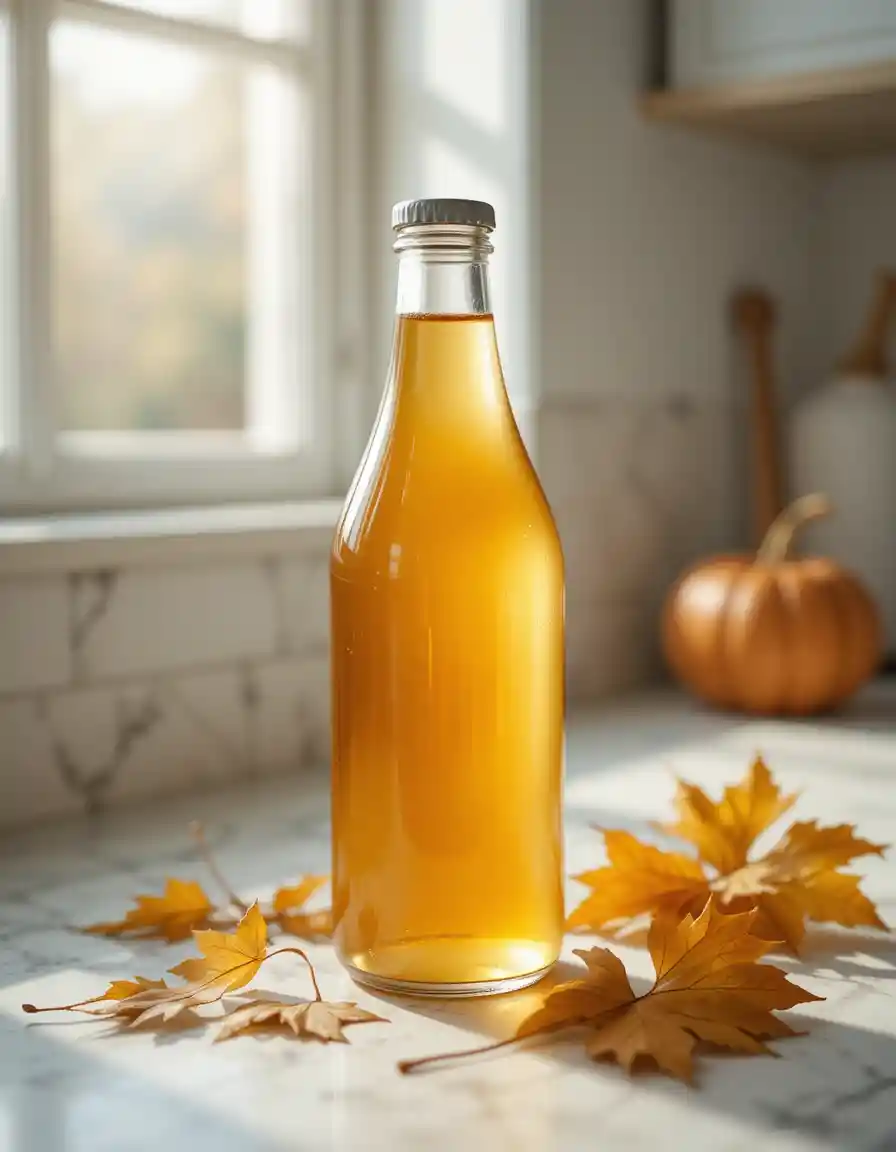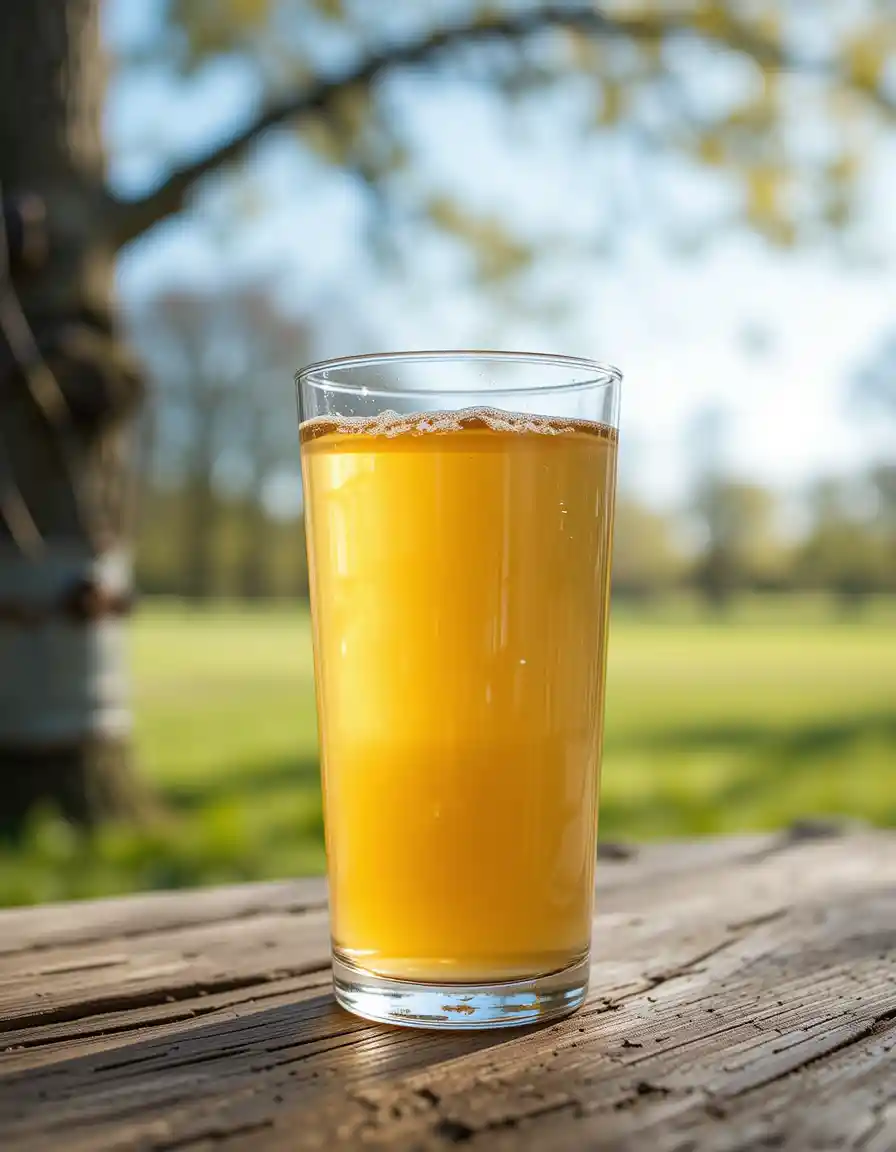Maple Juice
Maple Juice: Nature’s Secret Drink You’ve Probably Never Tried!
Ever heard of maple juice? No, it’s not maple syrup — and it’s not just for pancakes either. While most folks only know about the sweet, sticky syrup, few realize that the clear, refreshing sap collected straight from maple trees — known as maple juice — is packed with natural goodness that can boost your hydration, support your health, and even replace your morning sports drink.

If you’re tired of sugary beverages and looking for a pure, plant-based alternative loaded with minerals and antioxidants, you’re in the right place. In this post, you’ll discover exactly what maple juice is, how it’s different from syrup, its powerful health benefits, easy ways to make it at home, and smart tips to enjoy it every day.
Let’s dive into the surprising world of maple juice — nature’s original energy drink!
Table of Contents
Nutritional & Recipe Info
Preparation Time: 10 minutes (if using fresh sap)
Cooking Time: 0 minutes (no cooking required)
Total Time: 10 minutes
Type: Beverage / Natural Drink
Cuisine: North American / Canadian / Healthy Drinks
Recipe Yield: 4 cups (depending on collected sap)
Calories: 20 calories per cup
Maple Juice vs Maple Syrup: What You Need to Know
Most people automatically think of sticky, golden maple syrup when they hear “maple.” But what many don’t realize is that before syrup ever hits your breakfast plate, it starts off as something entirely different: maple juice.
The Truth About Maple Juice
Maple juice is the raw, unprocessed sap that flows from sugar maple trees every spring. Freshly gathered from the tree, it’s clear as crystal, gently sweet, and wonderfully refreshing. Unlike sugary drinks, maple juice delivers a clean taste with subtle hints of sweetness, along with a variety of natural minerals your body actually needs.
How Maple Syrup Is Made
To create maple syrup, this sap is boiled for hours to remove most of its water content. As the liquid thickens, the sugars become highly concentrated, giving syrup its familiar sweetness and thick texture. While delicious, this process dramatically increases the sugar and calorie content.
The Bottom Line Difference
| Maple Juice | Maple Syrup |
|---|---|
| Fresh sap from maple trees | Boiled, concentrated sap |
| Clear, mild flavor | Thick, intensely sweet |
| Low sugar, low calorie | High sugar, high calorie |
| Contains natural electrolytes and minerals | Mostly sugars and carbohydrates |
While both come from the same source, the nutritional profiles and health benefits are very different. Maple juice stands out as a natural, lower-calorie option for hydration and daily wellness, while maple syrup remains a popular sweetener for occasional indulgence.
Understanding this difference helps you make smarter choices depending on whether you’re looking for a refreshing drink or a sweet treat.

Health Benefits of Maple Juice
When it comes to natural drinks, maple juice is one of those underrated gems that most people have never fully explored. Tapped fresh from sugar maple trees, it offers far more than just a hint of sweetness — it brings real nutritional benefits that make it stand out from most store-bought beverages.
A Natural Source of Hydration
Maple juice contains about 95-98% water, making it an excellent way to stay hydrated. But unlike plain water, it also carries trace amounts of essential nutrients that your body can easily absorb. Some athletes even use it as a natural alternative to sports drinks because of its electrolyte content.
Rich in Electrolytes and Minerals
Inside each sip, you’ll find small amounts of potassium, calcium, magnesium, and manganese — all of which play important roles in maintaining muscle function, bone health, and energy balance. These minerals help your body stay balanced, especially after physical activity or on hot days.
Low in Sugar and Calories
Compared to processed fruit juices or energy drinks, maple juice is naturally low in both sugar and calories. One cup contains just a few grams of natural sugar, making it a smart option for anyone looking to reduce sugar intake without sacrificing flavor.
Packed with Antioxidants
Though it’s not widely promoted, maple juice contains plant-based antioxidants that help fight free radicals — unstable molecules that can contribute to aging and chronic disease. While you won’t get the same antioxidant punch as some fruits, every bit helps when building a balanced diet.
Supports Gut Health
Some studies suggest that certain compounds in maple sap may have prebiotic effects, potentially supporting healthy digestion. While more research is still ongoing, early findings are promising.
Chemical-Free and Naturally Sourced
Unlike many bottled drinks on store shelves, pure maple juice comes directly from trees — no additives, preservatives, or artificial colors. When consumed fresh or minimally processed, you’re drinking one of nature’s most simple and pure beverages.
With all these incredible benefits, it’s clear why maple juice is gaining attention as a natural, refreshing drink that goes far beyond its sugary cousin, maple syrup. Now that you know why it’s so good for you, the next step is simple — let’s roll up our sleeves and learn how you can collect and enjoy fresh maple juice right at home.
The Latest Recipes
How to Make Maple Juice at Home
You don’t need to be a professional syrup maker to enjoy fresh maple juice. With just a few basic tools, a little patience, and access to the right trees, you can tap into one of nature’s purest drinks right from your own backyard.
1. Find the Right Tree
Not all maple trees are the same. Sugar maples (Acer saccharum) are your best bet, as their sap contains the highest natural sugar levels. While red and black maples can also be tapped, sugar maples offer superior flavor and sap yield.
2. Choose the Right Time
The best time to collect maple juice is late winter to early spring, when daytime temperatures rise above freezing (around 40°F or 4°C), and nights still drop below freezing. This temperature swing creates the pressure that allows sap to flow.
3. Gather Your Supplies
- A cordless drill with a 5/16 or 7/16 inch drill bit
- Spiles (tapping spouts)
- Food-grade collection buckets or bags
- Hammer or mallet
- Cheesecloth or fine mesh strainer
4. Tap the Tree
Drill a hole about 1.5 to 2 inches deep at a slight upward angle, roughly 3 feet from the ground.Drive the spile gently into the tree, using light taps with a hammer until it stays firmly in place.
5. Collect the Maple Juice
Hang your collection container on the spile. Depending on the tree and weather, one tree can produce several gallons of sap per day.
6. Filter and Store
Once collected, strain the juice through cheesecloth to remove any debris. Place in the fridge and consume soon after to keep it tasting its freshest.
7. Optional Pasteurization
If you want to store maple juice longer, gently heat it to about 165°F (74°C) for 30 seconds to pasteurize. Let it cool and refrigerate immediately.
Fresh maple juice offers a crisp, slightly sweet taste unlike anything from the store. And the best part?
Now that you know how easy it is to make maple juice, let’s dive into some creative ways you can enjoy it every day.

Creative Ways to Use Maple Juice
Now that you’ve got your fresh maple juice, you might be wondering: how do I actually use it? The beauty of maple juice is its versatility. It’s not just a drink; it’s a natural ingredient that can sneak into your daily routine in surprising ways.
1. Enjoy It Straight
Sometimes, simple is best. Chill your maple juice and enjoy it as a refreshing, lightly sweet beverage. It’s a great alternative to plain water, especially on hot days or after a workout when your body craves electrolytes.
2. Smoothies and Shakes
Maple juice makes a fantastic base for smoothies. Blend it with your favorite fruits, some spinach or kale, and a scoop of protein powder. You’ll get a naturally sweet, nutrient-rich drink without added sugars.
3. Cooking and Baking
Use maple juice in place of water or milk in recipes like pancakes, muffins, or oatmeal. The natural sweetness can enhance baked goods without overpowering them.
4. Popsicles and Ice Cubes
Freeze maple juice into ice cubes or popsicles for a hydrating, slightly sweet frozen treat. Kids love them, and adults do too on a hot summer afternoon.
5. Light Cocktails and Mocktails
Maple juice adds a natural twist to homemade cocktails and mocktails. Mix it with sparkling water, a splash of lemon or lime, and a sprig of mint for a refreshing, non-alcoholic drink.
Trending Recipes Now
المؤشرات كلها تميل لطرف واحد في نهائي المغرب والأردن
رونالدو يتنبأ ببطل كأس العرب: «منتخب واحد فقط يملك عقلية الفوز باللقب»
Is Maple Juice Good for Everyone?
Maple juice sounds like a natural winner — but like anything, it’s not one-size-fits-all. Let’s break it down so you know if it fits your lifestyle.
Great for Most People
For most healthy adults and kids, maple juice is a refreshing, nutrient-rich drink. It’s low in sugar compared to fruit juices and loaded with minerals like potassium and calcium. If you’re trying to cut back on processed sugars but still want a hint of natural sweetness, maple juice hits the sweet spot.
Athletes & Active Folks
Because of its natural electrolytes, maple juice can be a good option for hydration after workouts, sports, or outdoor activities. It helps restore minerals lost through sweat, much like popular sports drinks — but without the added artificial colors, flavors, or high sugar content.
Good for Those Watching Their Sugar Intake (With Moderation)
While maple juice is lower in sugar than maple syrup or soda, it’s not completely sugar-free. If you’re diabetic or watching your blood sugar closely, it’s still smart to monitor your intake and discuss it with your healthcare provider.
Pregnant Women & Kids
In moderation, maple juice is generally safe for pregnant women and children. It’s chemical-free and naturally sourced, but always check with a doctor if you have any health concerns or dietary restrictions.
Who Should Be Careful?
- Individuals with kidney issues may need to limit high-potassium foods and drinks.
- Anyone allergic to tree sap or certain tree pollens (rare, but possible) should avoid it.
- If you’re on a very low-carb or ketogenic diet, even the small amount of natural sugar may not fit your plan.
In short, maple juice is a great fit for most people looking for a clean, refreshing drink — but like any food, it’s always best to enjoy it as part of a balanced diet.
The Latest Recipes
Potential Side Effects and Precautions of Maple Juice
Even though maple juice comes straight from nature, it’s still smart to know the possible downsides. Let’s be real — no food or drink is completely perfect for everyone.
1. Natural Sugar Content
While maple juice has far less sugar than maple syrup or processed juices, it still contains natural sugars. If you drink large amounts regularly, it could add up, especially if you’re trying to control your blood sugar or manage your weight.
2. Short Shelf Life
Because it’s so fresh and minimally processed, maple juice doesn’t last long in the fridge. It can start to ferment or spoil after just a few days. Always store it properly and consume it quickly for the best taste and safety.
3. Possible Allergic Reactions
Very rarely, some people might experience an allergic reaction due to tree pollens or proteins in the sap. If you’ve had issues with tree pollen allergies before, start with a small amount and monitor your body’s response.
4. Digestive Upset (If Overconsumed)
Drinking too much at once might cause mild bloating or an upset stomach, especially for people with sensitive digestive systems. Like most things, moderation is key.
5. Contamination Risks (If Tapped Incorrectly)
If you’re tapping your own trees, hygiene is crucial. Unclean equipment or improper storage can lead to bacterial growth. Always sanitize your tools and containers to keep your maple juice safe.
6. High Potassium (For Some Medical Conditions)
Maple juice contains potassium, which is great for most people — but not for everyone. If you have kidney problems or are on potassium-restricted diets, consult your doctor before drinking regularly.
The good news? For most folks, maple juice is a safe, wholesome, and enjoyable drink. But knowing the risks helps you make smart choices and get the most out of every sip.

Where to Buy Maple Juice
If you’re not quite ready to tap your own trees — no worries! Thankfully, maple juice is becoming easier to find as more people catch on to its health benefits and clean, natural flavor.
1. Local Farmers’ Markets
One of the best places to score fresh maple juice is your local farmers’ market, especially if you live in areas where maple trees are common, like the northeastern U.S. and parts of Canada. You’ll often find small-scale producers selling fresh batches during sap season (late winter through early spring).
2. Health Food Stores & Co-ops
Specialty grocery stores, organic markets, and food co-ops may carry bottled maple water (another name for maple juice). Brands like SEVA, Drink Maple, and Maple3 have made it more widely available in recent years.
3. Online Retailers
If you can’t find it locally, the internet’s got your back. Websites like Amazon, Thrive Market, or the companies’ own online stores ship directly to your door. Look for pure maple water with no added sugars or preservatives for the cleanest option.
4. Direct From Maple Farms
Many maple syrup producers also sell maple juice or water during tapping season. Some small farms offer it fresh, bottled, or frozen. Buying direct supports small businesses and guarantees maximum freshness.
5. Specialty Beverage Shops
A growing number of wellness cafes, smoothie shops, and health-oriented juice bars are adding maple juice to their menus. It’s worth asking if your favorite spot carries it!
Final Thoughts: My Maple Juice Experience
I’ll be honest — when I first tried making maple juice, I wasn’t sure what to expect. But the moment that fresh, lightly sweet liquid hit my taste buds, I was hooked. There’s something truly special about knowing you’re drinking straight from nature, without any extra processing or added junk.
The whole process — from tapping the tree to sipping that first glass — gave me a new appreciation for how simple, pure, and rewarding homemade foods can be. Maple juice has now become a regular part of my routine, whether I’m blending it into smoothies, freezing it into refreshing popsicles, or simply drinking it chilled on a warm afternoon.
Thank you so much for taking the time to read this guide. I hope it inspired you to explore the world of maple juice for yourself. If you enjoyed this article, I’ve got plenty more recipes, tips, and unique ideas waiting for you. Feel free to check out more posts right here on Joyful Cakes — there’s always something new to discover!
Related Posts
Frequently Asked Questions About Maple Juice
1. What does maple juice taste like?
Maple juice has a very light, slightly sweet taste with a hint of earthy, woody notes. It’s not as sugary as syrup — think of it more like flavored water with a subtle maple touch.
2. Is maple juice healthy?
Yes! Maple juice is naturally rich in electrolytes like potassium, magnesium, and calcium. It’s low in calories and sugars compared to many other juices, making it a hydrating and healthy choice for most people.
3. Where can I buy maple juice?
You can find maple juice at health food stores, farmers’ markets, specialty online retailers, or directly from maple farms. Always choose 100% pure maple water without added sugars or preservatives.
4. How long does maple juice last?
Fresh maple juice has a short shelf life — usually 5 to 7 days when refrigerated. Some bottled versions may last longer if pasteurized, but always check the expiration date.
5. Does maple juice have sugar?
Yes, but in very small amounts compared to other juices or sweetened beverages. On average, one cup of maple juice contains 2 to 5 grams of natural sugar, depending on the tree and season.
6. Can maple juice help with hydration?
Absolutely. Thanks to its electrolytes, maple juice is a great natural option for staying hydrated, especially after exercise or on hot days.
7. Is maple juice good for weight loss?
Because it’s low in calories and sugars, maple juice can be a smart drink choice if you’re watching your weight. However, like any food or drink, it should be enjoyed in moderation as part of a balanced diet.






